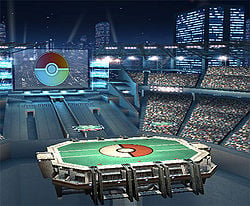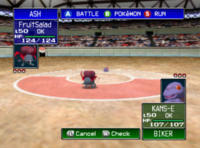Pokémon Stadium 2
| Pokémon Stadium 2 | |
|---|---|
 File:PokemonSymbol.png | |
| Universe | Pokémon |
| Appears in | SSBB |
| Availability | Starter |
| Crate type | Futuristic |
Pokémon Stadium 2 is a stage for Super Smash Bros. Brawl, based on (as its name suggests) the Pokémon universe. The basic layout of the stage is essentially unchanged from Super Smash Bros. Melee's Pokémon Stadium, save for a major graphical upgrade, including a huge space between the crowd and the stadium. The name of this stadium might be a reference to the game Pokémon Stadium 2 for the Nintendo 64. As with the original Pokémon Stadium, every so often, the stage transforms to represent a certain Pokémon type (see "Elements" below). However, unlike its predecessor, Pokémon will occasionally appear in the background.
Origin
A stage such as this has never been seen in any main series Pokémon game. There have been flat areas where trainers would do battle, but they were always inside buildings called gyms. One reference could possibly be from the game Pokémon Stadium. The arenas in Pokémon Stadium have the Pokéball logo in the center with crowds watching the battle. Another possible origin is from the anime. There have been gyms with a theme based on a Pokémon type, such as rock or electric, and the scenery would change to match the theme. However, the exact arrangements in this stage have never been seen in a Pokémon title. A possible source of inspiration for both this stage and its predecessor is the Pokémon anime television show, in which type-transforming arenas featured during the Pokémon League.
It is unconfirmed as to which region exactly the stage is set in, but reasons can be found for each region in the mainstream games.
- Kanto: The original Pokémon Stadium was set in Kanto.
- Johto: The Nintendo 64 game of the same name introduced the Johto region's Pokémon to 3D, and may have been set in Johto itself.
- Hoenn: The Generation Three battle theme Wild Pokémon Battle! (Ruby/Sapphire) is the only "true" battle theme to appear on the stage. The theme originates from the Hoenn region.
- Sinnoh: The stage stars a number of Sinnoh-only Pokémon. In addition to this, the Brawl stage Spear Pillar originates in Sinnoh.
Comparing with the background (skyscrapers), it may be Saffron City or Celadon City of Kanto, Goldenrod City of Johto, Lilycove City of Hoenn, or the Fight /Battle Frontier of Sinnoh. It may be a mix, if the buildings seen are from various cities/regions. Alternatively, it may be White City from the game Pokémon Stadium 2.
Songs in My Music
- Pokémon Main Theme
- Road to Viridian City (From Pallet Town/Pewter City)
- Pokémon Center
- Pokémon Gym/Evolution
- Wild Pokémon Battle! (Ruby/Sapphire)
Songs in bold must be unlocked
Elements
There are four possible stage transformations, each of which represents a particular type from the Pokémon games. While this feature was in the Melee version as well, the types represented in Brawl are all new. Whenever the stage transforms, the layout of its platforms changes, and in some cases the very physics of the game becomes altered as well. There is no specific order that these elements appear in - the stage transformation is completely random and it is even possible for the stadium to change into the same type twice in a row. However, the stage always begins on the standard arena and has to revert back to its normal state before transforming again. The elements are as follows:
- Electric: Has two conveyor belts near the edges on the stage, both rotating outward. The two platforms are replaced by three platforms in varying locations, either above the center of the stage, above either conveyor belt, or very high above the center of the stage.
- Flying: Fans in the ground create an updraft that enhances all characters' jumping abilities and delays falling time drastically. Characters flung upward have a much higher chance of being Star KO'ed. The updraft only extends above the platform. Both floating platforms disappear, giving the stage a Final Destination style layout.
- Ground: The layout changes to a large mound of dirt and a hut built into a tall rock. The hut provides two platforms, the lower one being longer and curved, and the higher one being short and flat. No physical effects are added.
- Ice: Makes all platforms and surfaces extremely slippery, so characters are more likely to trip. A hut can be seen in the background, and the two standard platforms are replaced by two icy platforms that slope inwards slightly.
Pokémon
A new feature in Pokémon Stadium 2 is the guest Pokémon who appear in the background of altered stages. They have no effect on the battle itself, but provide a nice addition to the scenery.
- Electric: Electivire and Magnezone
- Flying: Drifloon, Hoppip, and Skarmory.
- Ground: Cubone and Dugtrio, as well as a mysterious fossil.
- Ice: Snorunt and Snover.
Easter egg
In the Stadium's Ice mode, there is a cabin in the middle of the stage. Hidden in the cabin is a poster of a kitten as well as what looks like the Wii Hint Cat on the same poster. It is unknown whose kitten is pictured on the poster, but it is rumored to be Masahiro Sakurai's.
- Cat2.jpg
- Cat1.jpg
Gallery
Trivia
- It is widely believed that the Flying transformation of Pokémon Stadium 2 is based on the Valley Windworks from the Sinnoh region. The inclusion of wind turbines is the main reason people think this. To further back up the theory, the rare Pokémon Drifloon makes a guest appearance here. In Diamond/Pearl/Platinum, the Valley Windworks was the only location where a Drifloon could be encountered.
- Unlike the Melee Pokémon Stadium, characters fly in front of the screen in the background when Star KO'ed. In the original one, characters fly behind the screen.
- In the original Dojo screenshot of the Flying element of the stage, Drifloon and Hoppip are shown much farther away than in the final version of Brawl.
- When playing as Wario or Wario-Man, using a fully charged Wario Waft on the Flying stage will result in an instant Star KO.
- If one is looking through Luigi's Negative Zone at the screen behind the stadium, if the screen is showing a place in the Negative Zone as well, due to the double negative, the player will be able to see the true colors there.
External Links



